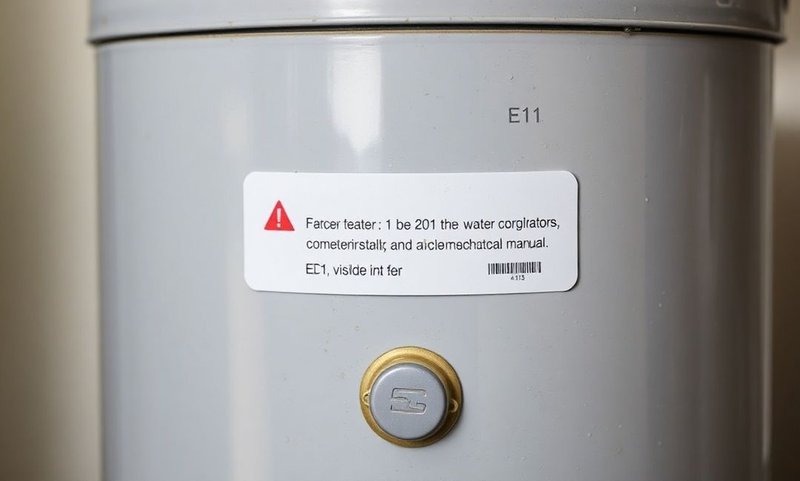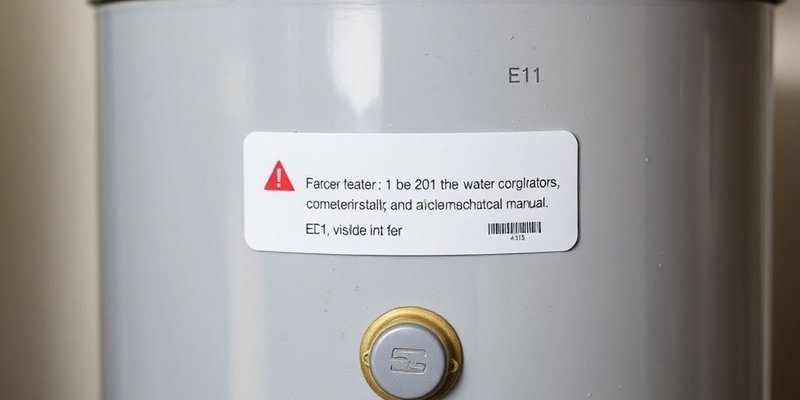
The “E1” error code on a Bradford White water heater typically points towards an ignition failure. This is kind of like when you try to start your car but the engine just won’t turn over. In simpler terms, your water heater is trying its best to heat the water, but something is preventing the ignition process from occurring. But don’t worry, understanding the common causes can help you identify and potentially fix the problem without too much hassle.
Understanding the Ignition System in Water Heaters
Before tackling the causes, let’s first get acquainted with the ignition system of a water heater. Think of it like the starter in your car. It kicks into action to ignite the gas burner, which then heats the water. The ignition process involves several components, including the igniter, gas valves, and control board. If any part of this system isn’t working correctly, you’ll likely end up with the E1 error code staring back at you.
Each time you request hot water by turning on the tap, your heater receives a signal to ignite the burner. If the burner doesn’t light up, the system will attempt a few more times before finally giving up and throwing that E1 error code. It’s the heater’s way of saying, “Hey, I tried, but something’s off!” Understanding this sequence can help demystify why ignition failures happen.
For many homeowners, this could sound a bit technical. However, if you think about it like this: if the igniter is like a matchstick, the gas is the fuel, and if either one isn’t available or working correctly, you won’t have a flame. So, when your water heater shows E1, it’s likely checking off a list of what isn’t happening as expected.
Common Causes of the E1 Error Code
So, what’s tripping up the ignition system? One of the most frequent culprits is a dirty or faulty igniter. Just like how a matchstick won’t light if it’s wet, an igniter that’s covered in grime or broken won’t do its job. Cleaning or replacing this part is often a straightforward fix and can restore normal function to your heater.
Another possibility is an issue with the gas supply. Imagine trying to fill a cup under a turned-off faucet—nothing’s going to happen. Similarly, if the gas valve isn’t open or there’s an obstruction in the line, the heater can’t light the flame. Checking the gas supply, ensuring the valve is open, and seeing that there’s no blockage can often solve the problem.
And then there’s the control board, which is like the brain of your heater. Sometimes, it might not send the right signals to ignite the burner. This can be due to electrical issues or even software glitches. It might sound complicated, but often resetting the system or checking connections can rectify this glitch. However, if it persists, consulting a professional might be your best bet.
How to Troubleshoot and Fix the E1 Error Code
Here’s the deal: before diving into repairs, safety comes first. Always ensure the power and gas supply are turned off before inspecting your water heater. Now, if the igniter is suspect, it’s usually accessible through a small panel. You can gently clean it with a soft brush or cloth to remove any debris. If that doesn’t work, replacing it could be necessary. Replacement parts are often available at hardware stores or through the manufacturer.
If you suspect a gas supply issue, double-check that the gas valve is fully open. This could be as simple as turning a knob. However, if you smell gas or suspect a leak, it’s crucial to contact a professional immediately. Gas is nothing to mess around with, and safety should always be a priority.
When it comes to the control board, if you’re comfortable, you can attempt a system reset by turning the unit off and on again. But if the error persists, it might be time to call in a technician. They have the tools and expertise to diagnose control board issues effectively.
Preventative Measures to Keep Your Water Heater Running Smoothly
You might be wondering—is there a way to prevent these issues from cropping up in the first place? Absolutely! Regular maintenance is key to keeping your water heater, and indeed any appliance, in top shape.
Keeping the igniter clean is one simple step. Regular checks every few months can help you spot dirt or issues before they lead to a dreaded E1 error code. Additionally, ensuring the area around your water heater is free from dust and debris can make a big difference. Think of it as giving your heater room to breathe—it needs clear air to work effectively.
Likewise, periodically checking your gas connections and valves for leaks or obstructions can prevent a host of problems. Using a soapy water solution can help spot leaks; bubbles will form if there’s any escaping gas.
Lastly, if you’re not using your heater for an extended period, consider shutting it down entirely. This can prevent any unnecessary wear and tear. Furthermore, annual professional check-ups can catch potential problems before they escalate.
By understanding and maintaining your water heater, you’ll not only extend its life but also save yourself the headache of unexpected cold showers and mysterious error codes. And remember, when in doubt, calling in a professional can ensure your water heater gets the care it needs to keep your showers blissfully warm.
